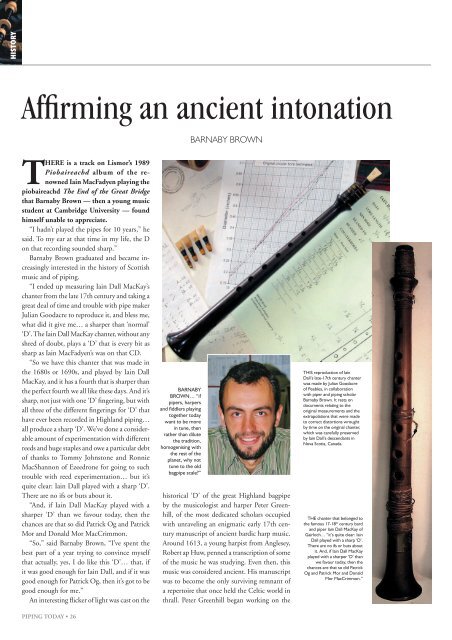Cap Caval - Pibroch.net
Cap Caval - Pibroch.net
Cap Caval - Pibroch.net
You also want an ePaper? Increase the reach of your titles
YUMPU automatically turns print PDFs into web optimized ePapers that Google loves.
HISTORY<br />
Affirming an ancient intonation<br />
THERE is a track on Lismor’s 1<br />
Piobaireachd album of the renowned<br />
Iain MacFadyen playing the<br />
piobaireachd The End of the Great Bridge<br />
that Barnaby Brown — then a young music<br />
student at Cambridge University — found<br />
himself unable to appreciate.<br />
“I hadn’t played the pipes for 10 years,” he<br />
said. To my ear at that time in my life, the D<br />
on that recording sounded sharp.”<br />
Barnaby Brown graduated and became increasingly<br />
interested in the history of Scottish<br />
music and of piping.<br />
“I ended up measuring Iain Dall MacKay’s<br />
chanter from the late 17th century and taking a<br />
great deal of time and trouble with pipe maker<br />
Julian Goodacre to reproduce it, and bless me,<br />
what did it give me… a sharper than ‘normal’<br />
‘D’. The Iain Dall MacKay chanter, without any<br />
shred of doubt, plays a ‘D’ that is every bit as<br />
sharp as Iain MacFadyen’s was on that CD.<br />
“So we have this chanter that was made in<br />
the 1680s or 1690s, and played by Iain Dall<br />
MacKay, and it has a fourth that is sharper than<br />
the perfect fourth we all like these days. And it’s<br />
sharp, not just with one ‘D’ fingering, but with<br />
all three of the different fingerings for ‘D’ that<br />
have ever been recorded in Highland piping…<br />
all produce a sharp ‘D’. We’ve done a considerable<br />
amount of experimentation with different<br />
reeds and huge staples and owe a particular debt<br />
of thanks to Tommy Johnstone and Ronnie<br />
MacShannon of Ezeedrone for going to such<br />
trouble with reed experimentation… but it’s<br />
quite clear: Iain Dall played with a sharp ‘D’.<br />
There are no ifs or buts about it.<br />
“And, if Iain Dall MacKay played with a<br />
sharper ‘D’ than we favour today, then the<br />
chances are that so did Patrick Og and Patrick<br />
Mor and Donald Mor MacCrimmon.<br />
“So,” said Barnaby Brown, “I’ve spent the<br />
best part of a year trying to convince myself<br />
that actually, yes, I do like this ‘D’… that, if<br />
it was good enough for Iain Dall, and if it was<br />
good enough for Patrick Og, then it’s got to be<br />
good enough for me.”<br />
An interesting flicker of light was cast on the<br />
PIPING TODAY • 2<br />
BARNABY<br />
BROWN… “if<br />
pipers, harpers<br />
and fiddlers playing<br />
together today<br />
want to be more<br />
in tune, then<br />
rather than dilute<br />
the tradition,<br />
homogenising with<br />
the rest of the<br />
pla<strong>net</strong>, why not<br />
tune to the old<br />
bagpipe scale?”<br />
BARNABY BROWN<br />
historical ‘D’ of the great Highland bagpipe<br />
by the musicologist and harper Peter Greenhill,<br />
of the most dedicated scholars occupied<br />
with unraveling an enigmatic early 17th century<br />
manuscript of ancient bardic harp music.<br />
Around 1613, a young harpist from Anglesey,<br />
Robert ap Huw, penned a transcription of some<br />
of the music he was studying. Even then, this<br />
music was considered ancient. His manuscript<br />
was to become the only surviving remnant of<br />
a repertoire that once held the Celtic world in<br />
thrall. Peter Greenhill began working on the<br />
THIS reproduction of Iain<br />
Dall’s late-17th century chanter<br />
was made by Julian Goodacre<br />
of Peebles, in collaboration<br />
with piper and piping scholar<br />
Barnaby Brown. It rests on<br />
documents relating to the<br />
original measurements and the<br />
extrapolations that were made<br />
to correct distortions wrought<br />
by time on the original chanter,<br />
which was carefully preserved<br />
by Iain Dall’s descendants in<br />
Nova Scotia, Canada.<br />
THE chanter that belonged to<br />
the famous 17-18 th century bard<br />
and piper Iain Dall MacKay of<br />
Gairloch… “it’s quite clear: Iain<br />
Dall played with a sharp ‘D’.<br />
There are no ifs or buts about<br />
it. And, if Iain Dall MacKay<br />
played with a sharper ‘D’ than<br />
we favour today, then the<br />
chances are that so did Patrick<br />
Og and Patrick Mor and Donald<br />
Mor MacCrimmon.”


